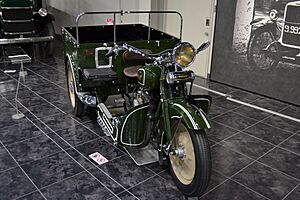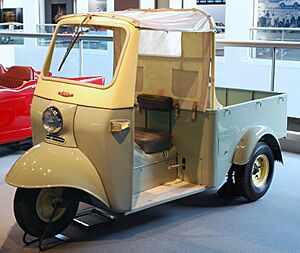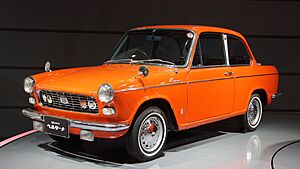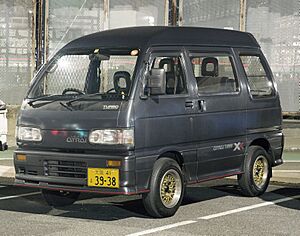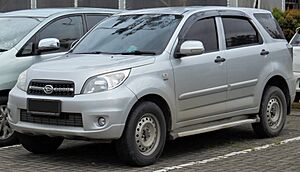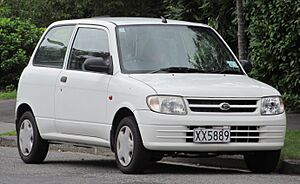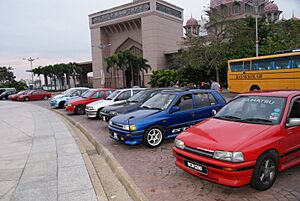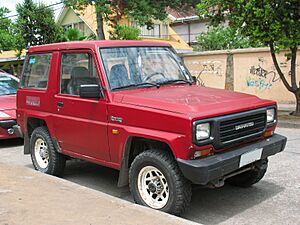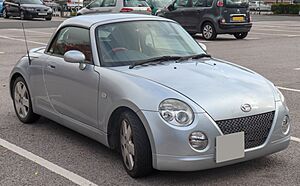Daihatsu facts for kids
 |
|
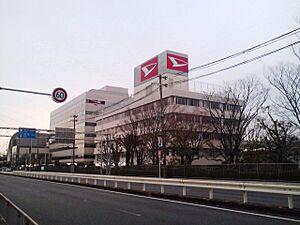
Daihatsu headquarters in Ikeda, Osaka
|
|
|
Native name
|
ダイハツ工業株式会社
|
|---|---|
|
Romanized name
|
Daihatsu Kōgyō Kabushiki-gaisha |
| Subsidiary | |
| Industry | Automotive |
| Predecessor | Hatsudoki Seizo Co., Ltd (1907–1951) |
| Founded | 1 March 1951 |
| Founders | Saneyasu Oka Zenjiro Takeuchi Yoshiaki Yasunaga Seishiro Tsurumi Masashi Kuwabara |
| Headquarters |
Ikeda, Osaka
,
Japan
|
|
Area served
|
|
|
Key people
|
Masahiro Inoue (president) |
| Products | Automobiles, engines |
|
Production output
|
|
| Revenue | |
|
Operating income
|
|
| Total assets | |
| Total equity | |
|
Number of employees
|
12,508 (April 2023) |
| Parent | Toyota Motor Corporation |
| Subsidiaries |
|
Daihatsu Motor Co., Ltd. (Japanese: ダイハツ工業株式会社, Hepburn: Daihatsu Kōgyō Kabushiki-gaisha) is a Japanese company that makes cars. Its main office is in Ikeda, Osaka Prefecture, Japan.
Daihatsu is one of the oldest Japanese companies that builds internal combustion engines. It was once famous for making three-wheeled vehicles and off-road vehicles. Today, the company mostly makes small cars called kei cars in Japan. These include small trucks, vans, and other compact cars. Because of this focus, many Daihatsu drivers in Japan are women. The company also makes small compact cars for places like Southeast Asia. These cars are often sold under the Toyota brand in growing markets around the world.
As of 2023, Daihatsu mainly sells cars in Japan and Indonesia under its own name. In Malaysia, it sells cars under the Perodua brand. The company has important research and development centers, factories, and sales teams in these areas.
Since August 2016, Daihatsu has been fully owned by the Toyota Motor Corporation. As of 2021, Daihatsu's car sales make up about four percent of all vehicles sold by the Toyota Group.
Contents
What Does the Name "Daihatsu" Mean?
The name "Daihatsu" comes from two Japanese words. It combines the first symbol (kanji) of Ōsaka (大), which means "big," and the first part of the word for "engine manufacture" (発動機製造, hatsudōki seizō). When put together, the "Ō" sound from Osaka changes to "Dai," making "Daihatsu."
A Look at Daihatsu's History
Daihatsu officially started on March 1, 1951. It took over from a company called Hatsudoki Seizo Co. Ltd, which began in 1907. Hatsudoki was first formed with help from Osaka University to create gasoline engines for small power plants. In its early years, Hatsudoki mostly made steam engines for trains. It also built rail cars for passengers. Later, it focused on diesel engines for railroads.
The company decided to start making cars in the late 1920s and 1930s. At that time, big car companies like Ford and General Motors had factories in Japan. They sold many cars there. Ford opened a factory in Yokohama in 1925, and GM opened one in Osaka in 1927. These factories were taken over by the Japanese government before World War II.
In the 1960s, Daihatsu started selling its cars in Europe. However, it didn't have much success there until the 1980s. In Japan, most Daihatsu cars are small kei cars.
Daihatsu was an independent carmaker until Toyota Motor Corporation became a major owner in 1967. This happened as the Japanese government wanted to open up its car market. Toyota slowly bought more shares in Daihatsu. By 1998, Toyota owned more than half of the company. This meant Toyota had control over Daihatsu. At that time, Daihatsu was already making mini-vehicles and small cars for Toyota.
After the 2008 financial crisis, Daihatsu's sales in Europe dropped a lot. They went from 58,000 cars in 2007 to just 12,000 in 2011. Daihatsu left the European market by 2013. This was because the Japanese currency (yen) was very strong. This made it hard for the company to make money from selling cars overseas.
In August 2011, Daihatsu invested 20 billion yen (about $238.9 million) in Indonesia. They built a factory there to make affordable cars. This factory started making cars at the end of 2012. It could produce up to 100,000 cars each year.
In August 2016, Daihatsu became a company fully owned by Toyota Motor Corporation. In January 2017, Daihatsu and Toyota created a new team together. This team focuses on making small cars for growing markets around the world. Daihatsu is in charge of planning the cars and making sure they are good quality. Both companies work together on business plans.
In October 2016, Daihatsu and Toyota announced a new way to build cars. They called it the Daihatsu New Global Architecture (DNGA). The second version of the Mira e:S was the first car to use this new design in 2017. Later, the company changed the definition of DNGA. They then said the fourth-generation Tanto was the first true DNGA model.
From 2020 to 2022, Daihatsu helped train employees from another Toyota company. This training aimed to improve how small cars were developed and made.
Safety Concerns and Actions
In April 2023, Daihatsu found some issues with its safety tests. The company announced that it had found problems in how some safety tests were done. Most of these cars were sold as Toyota Yaris in places like Thailand and Mexico.
In December 2023, the company stopped shipping 64 different car models. This included cars sold by Mazda, Subaru, and many models branded as Toyotas. Investigations found more widespread issues than first thought. For example, in some cars, the airbag part used in testing was different from the one in cars sold to people. Also, some test results for speed and headrests were not correct. These issues went back as far as 1989, becoming more common after 2014. Cars in Japan and many other countries were affected. The company stopped production at all its factories in Japan to fix these problems. Shipments and production restarted in early 2024 after the issues were addressed.
Company Milestones
Daihatsu Motor Co., Ltd. was officially formed on March 1, 1951. In 1963, the company launched the Daihatsu Compagno. This car used one design for many different body styles. Also, the well-known "D" logo was introduced that year. Just one year later, on September 1, 1964, Daihatsu built its one millionth vehicle. In 1965, the Daihatsu Compagno Berlina was sold in the United Kingdom. This was the first time a Japanese car was sold in the UK.
In 1967, Daihatsu started working with Toyota Motor Corporation. By 1968, Daihatsu had made one million of its small "kei" cars. The two millionth Daihatsu car was built in 1969. In 1971, Daihatsu launched its first Delta Truck model in Japan. This was a six-ton cargo truck influenced by Toyota. By 1975, Daihatsu began providing diesel engines to a Portuguese company. These engines were for their 4X4 off-road vehicles.
The 1980s were important for Daihatsu. By 1980, it had made three million kei cars. In 1987, the company started selling cars in the US market with the Hijet. Then, the Rocky and Charade models followed in 1988. However, in 1992, Daihatsu stopped selling cars in the US.
In 1998, Toyota gained control of Daihatsu by buying 51.2% of the company. Daihatsu's presence in Europe also decreased in the 2010s. The company announced that it would stop selling cars in Europe by January 31, 2013. In 2011, Daihatsu invested 20 billion yen (about $238.9 million) in a factory in Indonesia. This factory was built to produce affordable cars.
In 2016, Toyota bought all remaining parts of Daihatsu. This made Daihatsu a fully owned part of Toyota.
Company Leaders
- Mizuo Takezaki (1947–1955)
- Koishi Yuji (1955–1968)
- Yoshikichi Ise (1968–1975)
- Ohara Sakae (1975–1982)
- Tomoko Eguchi (1982–1988)
- Jiro Osuga (1988–1992)
- Takashi Toyozumi (1992–1995)
- Takeichi Shingu (1995–2000)
- Takaya Yamada (2000–2005)
- Teruyuki Minoura (2005–2010)
- Ina Koichi (2010–2013)
- Masanori Mitsui (2013–2017)
- Soichiro Okudaira (2017–2024)
- Masahiro Inoue (2024–present)
Where Daihatsu Sells Cars Around the World
Daihatsu first started selling cars overseas in 1953. By 1980, it had exported half a million vehicles. In 1979, a main office for Europe was set up in Brussels. Its job was to manage and grow sales in Western Europe. Since the late 1990s, Daihatsu's direct exports have been shrinking. However, some Daihatsu cars are sold through Toyota. Also, Daihatsu shares its technology with Malaysia's Perodua. Daihatsu has also provided cars to other carmakers in the past, which were then sold under different brand names. Today, Daihatsu supplies engines and parts to Perodua in Malaysia. Perodua makes and sells Daihatsu cars under its own brand there.
In February 1992, Daihatsu began selling cars in North America. From 1994 to 1999, it exported the Terios and Cuore models to Brazil. However, due to changes in currency values and an economic crisis in Asia, the brand stopped selling cars in Brazil.
Asia and Oceania Markets
After the 1997 Asian financial crisis, Daihatsu closed its factories in Thailand. It completely left that market. Before leaving in March 1998, it mostly sold the Mira range in Thailand. The Mira was also built there with some local changes.
Daihatsu had sold Charades and Miras in Malaysia since 1980. After the launch of Perodua, Daihatsu's operations in Malaysia became smaller. They focused only on commercial vehicles, selling their Delta and Gran Max commercial trucks.
In Indonesia, Daihatsu is still a very important company. It works with Astra Daihatsu Motor. This partnership oversees the local building of many Daihatsu cars and commercial vehicles for the Indonesian market since 1992. Astra Daihatsu Motor is the biggest car producer in Indonesia. Daihatsu is the second best-selling car brand in Indonesia, after Toyota.
On March 31, 2005, it was reported that Toyota would remove Daihatsu from the Australian market. This was because sales had dropped a lot in the years before. Daihatsu stopped its operations in Australia in March 2006, after almost 40 years there. At that time, the brand sold models like the Charade, Copen, Delta, Sirion, and Terios.
Toyota New Zealand announced on April 8, 2013, that sales of new Daihatsu vehicles in the country would stop by the end of that year. They said this was because there weren't enough products that would meet future New Zealand rules. No new vehicles were imported after that announcement.
Americas Markets
Daihatsu's sales in Chile also faced challenges after low sales in 2004 and 2005. Daihatsu was well known there for its 1970s models like the Charade. Toyota said it planned to stay in the Chilean market. Only the Terios model was available there until it was renamed the Toyota Rush in August 2016, as Daihatsu left that market.
In Trinidad and Tobago, Daihatsu has been present since 1958. Its Mark I Midget was popular among traders. From 1978 to 2001, a local dealer sold models like the Charmant, Rocky, and Terios. The Delta truck chassis remained popular. Now, Toyota Trinidad and Tobago Ltd. sells Daihatsu Terios, YRV, and Sirion models.
In the United States, Daihatsu cars were sold from 1988 to 1992. However, sales were affected by an economic slowdown in the 1990s. Also, Daihatsu's small, fuel-efficient cars did not match what American customers wanted. Only the Charade and the Rocky were sold. Starting in 1987, Daihatsu also sold the Hijet in the United States as a vehicle only for off-road use.
Daihatsu and Bombardier Inc. had plans to open a factory in Canada in 1989. They wanted to build the Charade there. Their bigger goal was to build a small car designed by Bombardier for North America. These plans did not happen. After Daihatsu left the US market, Toyota continued to provide support for existing Daihatsu customers until at least 2002.
Europe Markets
Cars from Daihatsu started being imported to Europe in 1979. The company had little presence in countries with trade barriers, like France and Spain. These countries had their own carmakers selling similar small cars. Daihatsu mainly sold cars in the United Kingdom, Germany, and the Netherlands. In Italy, Daihatsu worked with a local small car company called Innocenti in 1982. This helped Daihatsu enter several European markets. Innocenti used Daihatsu engines in their cars from 1983 to 1993.
Starting in 1992, Piaggio made the Hijet microvan and truck locally. It was sold as the Piaggio Porter or Daihatsu Hijet. It is still available today and is also built in India. In the mid-1980s, Daihatsu also briefly imported Charade cars to Italy. These cars were put together by Alfa Romeo's South African branch. This was another way to get around import rules.
Daihatsu announced on January 13, 2011, that it would stop selling cars across Europe on January 31, 2013. This was because the Japanese yen was getting stronger. This made car prices too high to compete. Daihatsu had no new cars in the UK at that time and did not plan to import more.
Africa Markets
From 1983 to 1985, Alfa Romeo's South African branch assembled the Charade. They sold it locally and exported it to Italy. In April 2015, the company left South Africa.
Electric and Hybrid Cars
Daihatsu has been working on electric vehicles for a long time. It started by making special "pavilion cars" for the 1970 Osaka World Expo. Then, it made golf carts and vehicles for special uses. An electric version of the company's Fellow Max small car was also made as a test car. The 1973 oil crisis made them work even harder on electric cars. At the 20th Tokyo Motor Show in 1973, Daihatsu showed an electric three-wheeled vehicle and other electric car ideas.
Daihatsu continued to show more test electric cars through the 1970s. In November 1974, Daihatsu released the Hallo. This was a tilting three-wheeled vehicle powered by an electric motor and two batteries.
In December 2011, Daihatsu released the Pico EV Concept. This was a small four-wheeled vehicle powered by an electric motor.
The company released a mild hybrid technology in 2007. It was called the Daihatsu Mild Hybrid System. This system was used in the Hijet/Atrai Hybrid-IV.
In November 2021, Daihatsu released its first mass-produced full hybrid system. It is called the "e-Smart Hybrid." This system is a series hybrid system. It is different from Toyota's more advanced hybrid technology. This technology was first used in the hybrid version of the A200 series Rocky. It is also used in the Toyota-branded model, the Raize.
Motorcycles
In 1973, Daihatsu showed an electric tilting three-wheeled vehicle at the Tokyo Motor Show. This vehicle, called the Hallo, started being made in 1975. Daihatsu also made a version of the Hallo that ran on gasoline. It used a small 50 cc engine.
Daihatsu's Logos
Daihatsu is well known for its special stylized D logo. This logo first appeared in September 1963 on the Daihatsu Compagno car. From when it started in 1951 until 1969, Daihatsu also used a logo that looked a bit like Ford's. It had the word "Daihatsu" written in a fancy style. Daihatsu also had another logo based on a drawing of Osaka Castle. This was used on its three-wheeled trucks in the 1950s and 1960s. The old wordmark logo was used in company brochures until November 1969. Because of this, in the 1950s and 1960s, Daihatsu was often called Japan's Ford.
In December 1969, the old logos were stopped. Daihatsu officially started using the D logo as its main company logo. The famous D logo is a modern version of the "D" from the earlier logo. It also looks like the Japanese "da" sound and a rocket or an arrow pointing forward. This shows Daihatsu's goal to keep moving forward and getting better. The stylized D also stands for Daihatsu. Starting in January 1970, the word "Daihatsu" was written below the D logo in a modern font.
The D logo, with a white D inside a red rectangle, has been used since late 1969. The first version of the D logo, surrounded by a circle, was on Daihatsu cars from 1963 to 1979. From 1979 to 1989, the D logo was inside a dark grey rectangle. In November 1989, the D logo was put inside an oval and made to look like chrome. This chrome D logo is still used today, with some small updates. The most recent update in 2004 made the chrome D logo bolder and bigger.
Daihatsu's Mascot
The mascot for Daihatsu Motors is Kakukaku Shikajika (カクカクシカジカ). He is a human-like deer character. He was created by an artist named Chiharu Sakazaki. Kakukaku wears a white shirt and black pants. He is drawn in a simple, lineless style. A Daihatsu representative said he has a "cool and slightly cynical" personality.
Kakukaku has appeared in many animated commercials for the company. He is also on various merchandise and promo items, mostly in Japan. He was first used to advertise the Daihatsu Move Conte car. He even had his own special edition of that car. He has been used in marketing since 2008.
He has also appeared in commercials shown on New Year's Day. In these, he talks about the company's sales. In 2018, Daihatsu had the most commercials running for a single company in Japan during the first three days of the year. Due to the safety issues found in 2023, these commercials were temporarily stopped. This made some TV viewers in Japan sad.
Kakukaku also has a group of dedicated fans, sometimes called the Kakukult. They draw fanart of the character.
There is also a less known mascot named Tufton. He is a blue bird character designed to advertise the Daihatsu Taft car line.
Where Daihatsu Cars Are Built
Daihatsu has several factories where it builds cars. Its first and oldest factory, called Ikeda Plant 1, was built in May 1939 in Ikeda, Osaka. The second factory, Ikeda Plant 2, was built in May 1961. It also has the main office for Osaka. The company has an office in Tokyo, which first opened in 1933.
Daihatsu also has two factories in Ryūō, Shiga. The first opened in April 1974, and the second in January 1989. Another factory opened in April 1973 in Ōyamazaki, Kyoto. Daihatsu opened two factories in Nakatsu, Ōita: Nakatsu Plant 1 in November 2004 and Nakatsu Plant 2 in November 2007. The Kurume Plant opened in August 2008 in Kurume.
Daihatsu also builds cars in other countries. For example, in Indonesia, it works with Astra Daihatsu Motor. They build cars like the Ayla, Gran Max, Luxio, Rocky, Sigra, Terios, and Xenia there. In Malaysia, Daihatsu works with Perodua. They build models like the Axia, Bezza, Ativa, Myvi, Aruz, and Alza.
|
See also
 In Spanish: Daihatsu para niños
In Spanish: Daihatsu para niños


